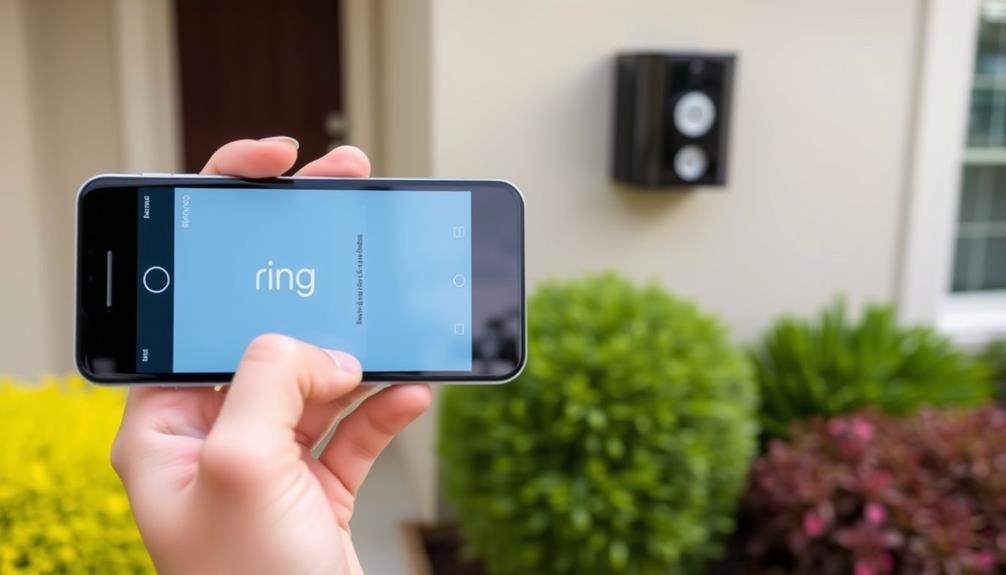To install your Ring Doorbell on brick, you have a few options. If you want a no-drill solution, use strong double-sided tape, ensuring your brick is smooth. For a more secure fit, drill into mortar using a masonry drill bit and plastic anchors. This method minimizes wall damage and simplifies future repairs. Make sure to measure and level properly before attaching the doorbell. If you encounter challenges like misalignment or tough brick, you can troubleshoot easily. Keep following along to discover additional tips for a smooth installation and enhance your overall experience with Ring. Another useful tip when installing a Ring Doorbell on brick is to use a pencil or marker to outline the exact placement before committing to drilling or taping. Additionally, always double-check your Wi-Fi signal strength at the installation location to ensure optimal performance. By carefully planning and following these steps, you can ensure a hassle-free experience when installing a Ring Doorbell on brick.
Key Takeaways
- Choose the appropriate installation method: no-drill mount, drilling into mortar, or DIY tape method based on your preference and surface condition.
- Use a masonry drill bit for drilling into brick or mortar, and ensure to drill at a 90-degree angle for accuracy.
- Employ a level tool to confirm straightness and proper alignment before securing the Ring Doorbell to the brick surface.
- Consider weather conditions; aim for dry days and check adhesive ratings to avoid installation issues due to moisture or temperature.
Overview of Installation Methods
When it comes to installing your Ring Doorbell, you've got three main methods to choose from, each with its own advantages and factors to weigh.
The first method is the no-drill mount, which utilizes strong double-sided tape for quick and easy installation. This option works best on smooth surfaces but may not be as durable on uneven textures. For those who've gas appliances, it's important to remember that safety precautions are necessary during any home installation, especially when using power tools.
Next, you can opt for drilling into mortar. This method is recommended for achieving a secure attachment while minimizing damage to the brick. You'll need masonry drill bits and plastic anchors to guarantee a stable fit. Drilling into mortar allows you to fill screw holes easily if you choose to remove the doorbell in the future.
Lastly, there's the DIY tape method, which allows for customizable adhesive strength but may not hold well over time.
Each installation method varies in ease, durability, and potential wall damage, so it's essential to take into account your specific surface and desired outcome when making your choice.
No matter which method you select, make sure you have the right tools and materials to get the job done effectively.
No-drill Mounting Options

No-drill mounting options offer a convenient and damage-free way to install your Ring Doorbell, particularly on smooth surfaces. The official Ring no-drill mount utilizes strong double-sided tape, allowing you to secure your doorbell without damaging the brick surface.
This mount is also waterproof, making it suitable for uncovered porch installations, although its effectiveness may vary depending on the texture of the brick. Additionally, using great explorers' quotes about journeys can inspire your installation process, reminding you of the adventure involved in setting up your home security.
If you're looking for a budget-friendly alternative, consider the DIY tape method. This approach allows you to customize the adhesive strength by selecting different types of double-sided tape from your local hardware store.
However, be cautious: while stronger adhesives can provide better support, they can potentially damage the brick upon removal. On the other hand, weaker strips mightn't hold up over time, leading to a less reliable installation.
Ultimately, the choice between the official no-drill mount and the DIY tape method depends on your specific needs and the condition of your brick surface. Whichever option you choose, make sure you follow the manufacturer's guidelines for the best results.
DIY Tape Method Explained

When using the DIY tape method for your Ring Doorbell, you'll want to take into account the different tape options available.
Not all tapes are created equal, so think about adhesive strength to guarantee your doorbell stays secure.
For example, using tape that can withstand varying weather conditions is vital, especially if you're installing it outdoors.
Additionally, you may want to explore options that offer air quality improvements, as some tapes may have features that reduce dust and allergens.
Choosing the right tape can make a big difference in both installation ease and long-term durability.
Tape Options Available
There are several tape options available for the DIY Tape Method to install your Ring Doorbell, allowing you to choose the best fit for your needs.
Standard double-sided tape is a budget-friendly choice, but if you're looking for stronger adhesion, contemplate industrial-strength tapes designed for mounting. These options hold up well on uneven surfaces, guaranteeing your doorbell stays secure regardless of the brick texture.
When selecting a tape, it's also helpful to reflect on the key factors in choosing a home cleaning service to guarantee a clean and suitable installation area.
If you prefer a less permanent solution, easy-removal strips can be a good option for quick installations. They allow for easy removal without damaging the brick, although they may not hold as firmly over time.
To enhance adhesion, you can apply multiple layers of tape, especially if the surface is irregular.
Local hardware stores typically stock these tape options, making it convenient to gather everything for your installation.
Just keep in mind that while convenient, strong adhesives might cause damage during removal, so weigh your options carefully.
Adhesive Strength Considerations
Choosing the right adhesive strength is essential for guaranteeing your Ring Doorbell stays securely in place, especially on uneven surfaces. Utilizing the DIY tape method, you can select between industrial or easy-removal double-sided tape based on your durability needs. Here's a quick overview of your options:
| Tape Type | Adhesive Strength |
|---|---|
| Standard Double-Sided | Moderate |
| Industrial Double-Sided | High |
| Easy-Removal Double-Sided | Low |
| Multiple Tape Layers | Enhanced Stability |
| Weather-Resistant Options | Improved Longevity |
Multiple layers of tape can considerably improve adhesion on uneven brick surfaces, enhancing your installation's overall stability. Remember that the effectiveness of your adhesive can vary based on environmental conditions and surface texture. Smooth surfaces usually provide better adherence than textured ones.
Before you begin, check your local hardware store for a variety of tape options that suit your needs. While standard double-sided tape is budget-friendly, be cautious with stronger adhesives as they may cause wall damage upon removal. So, choose wisely to guarantee your Ring Doorbell remains securely mounted.
Drilling Into Mortar

Drilling into mortar is often the best choice for mounting your Ring Doorbell, as it reduces damage and simplifies future repairs. Mortar joints are typically easier to work with than brick, making them ideal for secure installation.
Additionally, using the proper tools and techniques can enhance the overall stability of your device, similar to how a reliable garage door opener enhances home security.
To get started, you'll need a masonry drill bit, specifically designed for this purpose. Confirm the mortar joint is thick enough to support the weight of your Ring Doorbell before you proceed.
When you're ready to drill, position your drill at a 90-degree angle to the surface. This helps prevent any cracking in the mortar or uneven holes that could compromise the installation.
Once you've drilled the appropriate holes, insert plastic anchor bolts into the mortar. These anchors provide extra support for your device and help guarantee a stable mount.
It's essential to follow the manufacturer's guidelines for spacing and number of screws to achieve a secure installation.
Step-by-Step Installation Guide

Before you start installing your Ring Doorbell, you'll need to gather the right tools and materials to make the process smoother.
Consider checking out some breathtaking destinations for inspiration on where to relax after your installation is complete.
It's also helpful to be aware of common installation challenges you might face along the way.
Let's walk through the steps to guarantee a successful setup.
Required Tools and Materials
To successfully install your Ring Doorbell, you'll need a few essential tools and materials. Gathering these items beforehand will make your installation smoother and more efficient.
Here's what you'll need:
- Masonry Drill: This is vital for creating holes in the brick. Make sure to have the right masonry drill bits for effective drilling.
- Measuring Tape: Use this to accurately mark the desired location for your doorbell, ensuring it's at the right height and properly aligned.
- Level Tool: A level tool is important for ensuring your Ring Doorbell is installed straight. This adds to both its functionality and aesthetics.
- Plastic Anchors and Screwdriver: The plastic anchors included in the Ring package are necessary for securely mounting the doorbell into the drilled holes. Use a screwdriver to fasten the screws into the anchors, ensuring a solid attachment.
With these tools and materials on hand, you're ready to move forward with your installation!
Common Installation Challenges
Installing your Ring Doorbell can present several common challenges that you'll want to be prepared for.
One major hurdle is drilling into hard brick surfaces. Using a masonry drill bit and applying steady pressure can help you create clean holes without damaging the brick. Also, be mindful of misalignment; a level tool can guarantee your doorbell is mounted straight, avoiding future issues.
Weather can complicate your installation process as well. It's best to choose a calm, dry day to set up your doorbell, as rain or wind can make the job much more difficult. Additionally, if you're planning a hardwired installation, limited access to a power source could pose a problem. Make sure to plan your installation location accordingly to avoid this challenge.
Lastly, verify you have all the necessary tools on hand before starting. You may need a hammer drill or specific anchors for specialized installations. By being aware of these common challenges and preparing accordingly, you'll make the installation process smoother and more efficient.
Tools and Materials Needed

You'll need a few essential tools and materials to install your Ring Doorbell securely on brick. Gathering the right equipment will make the process smoother and guarantee your doorbell functions at its best. Here's what you'll need:
- Masonry drill bit: This specialized bit is important for drilling into hard brick surfaces, making clean holes for your anchors.
- Plastic anchors: These are critical for securely holding the screws in place. They make sure your doorbell remains stable and won't easily fall off.
- Screwdriver: A trusty screwdriver is necessary to fasten the screws into the plastic anchors after you've drilled the holes. It's important to have the right size for a snug fit.
- Level tool: This tool helps you mount the doorbell straight. A level installation is key for best camera functionality and aesthetics.
Additionally, you'll want a measuring tape to accurately determine the ideal height for installation, which is around 125 cm from the ground.
With these tools and materials, you'll be well on your way to a successful installation!
Common Installation Challenges

When installing your Ring Doorbell, you might run into a few common challenges.
Drilling into hard brick surfaces can be tough, and misalignment during installation could lead to issues down the line.
Plus, weather conditions can complicate the process, so it's crucial to plan accordingly.
Drilling Hard Brick Surfaces
Drilling into hard brick surfaces presents unique challenges that require the right tools and techniques for a successful installation. To guarantee you navigate this task effectively, follow these essential steps:
- Choose the Right Tools: Use a masonry drill bit specifically designed for durability, paired with a hammer drill to provide the necessary impact for penetrating tough brick.
- Start with a Pilot Hole: Begin by drilling a smaller pilot hole. This will guide your larger bit, helping maintain accuracy and preventing it from wandering.
- Apply Steady Pressure: While drilling, apply steady pressure. This technique not only helps prevent overheating but also prolongs the life of your drill bit.
- Prioritize Safety: Always wear safety goggles and a dust mask. Protecting yourself from debris and dust generated during the drilling process is essential.
Misalignment During Installation
Misalignment during installation can lead to frustrating setbacks, so taking the time to ascertain accurate positioning is essential for a successful setup of your Ring Doorbell.
Start by using a level tool to mark the installation height on your brick surface. This ascertains the doorbell will be straight before you drill any holes. After leveling, accurately mark the mounting holes with a pencil; even slight inaccuracies can result in visible misalignment once installed.
Before finalizing the installation, double-check the height and angle of the doorbell. Improper positioning can negatively affect the camera view and overall functionality.
If you find that misalignment occurs after installation, don't worry. Carefully remove the doorbell and re-drill the holes, but be cautious not to damage the surrounding brick or mortar.
To help achieve precise alignment, consider using a template or the mounting bracket provided with the Ring Doorbell. This will guide you in ascertaining proper positioning and minimize potential errors.
Weather-Related Installation Issues
Installing a Ring Doorbell can be tricky in adverse weather conditions, as rain, snow, or high winds may hinder proper adhesion and alignment. To guarantee a successful installation, consider the following tips:
- Choose the Right Day: Aim for a dry day to avoid moisture interference with adhesive materials. This helps to secure the doorbell effectively.
- Check Temperature Ratings: Cold temperatures can reduce the effectiveness of some adhesive materials. If you're installing in winter, opt for adhesives rated for low temperatures.
- Mind the Wind: Wind can create instability while you're drilling or positioning the doorbell. Ensure you're in a calm environment to maintain alignment during installation.
- Postpone if Necessary: If extreme weather is forecasted, it's wise to delay your installation. This prevents complications and guarantees a reliable setup for your Ring Doorbell.
Troubleshooting Common Issues

When you encounter issues with your Ring Doorbell, addressing them promptly can guarantee peak performance and security.
Common installation issues, like misalignment, can be easily fixed. Use a level tool to confirm your doorbell is straight before securing it. If your device feels loose or falls off, tighten the mounting screws and consider adding industrial-strength tape on uneven surfaces for extra support.
Power-related problems often stem from a battery that isn't fully charged or improper wiring. Make certain the battery is charged before installation and follow the wiring instructions carefully to avoid these issues.
Additionally, connectivity problems can arise if your doorbell is too far from the Wi-Fi router. Confirm the device is within an ideal range, and think about using a Wi-Fi extender if necessary.
Community Support Resources

Tap into the Ring Community to find valuable support resources, where users share their experiences and tips for installing devices on brick surfaces. This community offers a wealth of information that can make your installation of the Ring Video Doorbell smoother and more successful.
Here are four key resources you should explore:
- Forums: Engage in discussions with other users who've installed their Ring Doorbells on brick. You can ask questions and share your own experiences.
- Tutorials: Access step-by-step guides tailored specifically for installation on brick surfaces. These tutorials can provide the clarity you need.
- Troubleshooting Tips: Learn about common challenges and solutions from others who've faced similar issues. This can save you time and frustration during your installation.
- Feedback and Insights: Gain valuable advice on improving your installation techniques directly from the community, making your setup more effective.
Enhancing Your Ring Experience

Enhancing your Ring experience can be easily achieved by exploring features like the Ring Protect plan and refining your device settings. By subscribing to a Ring Protect plan, you gain access to video recording, cloud storage, and snapshot capture, all of which add extra layers of security and convenience.
Using the Ring app, customize your notification settings so you can receive alerts for specific events that matter most to you. To improve your Wi-Fi connection, verify your Ring device is mounted within ideal range. If needed, consider using a Wi-Fi extender to enhance connectivity, which can greatly improve performance.
Don't forget to engage with the Ring Community! These forums are a fantastic resource for sharing experiences, gaining insights from other users, and finding helpful troubleshooting tips related to your device.
Also, regularly check for firmware updates through the Ring app, as these can introduce new features and enhance your Ring's functionality.
Frequently Asked Questions
How Do You Install a Ring Doorbell on Brick Without Drilling?
To install a Ring Doorbell on brick without drilling, you've got a few options.
You can use the official No-drill Mount featuring strong double-sided tape, perfect for uncovered porches.
Alternatively, try a DIY approach with standard double-sided tape for customizable adhesion.
Command strips are another choice, but they might damage the brick when removed.
Just make sure the surface is smooth for the best results, as textured brick can hinder adhesion.
Can a Ring Doorbell Be Installed on Brick?
Yes, you can install a Ring Doorbell on brick.
There are several methods you can use, like no-drill mounts or drilling into mortar.
If you choose a no-drill option, make certain your brick surface is smooth for better adhesion.
If you prefer drilling, it's often safer to drill into mortar to avoid damaging the brick.
Whatever method you pick, just verify it suits your specific installation needs and the condition of your brick.
How to Install a Camera on a Brick Without Drilling?
Installing a camera on brick without drilling is like finding a way to balance a feather on a breeze—delicate but doable!
You can use the official no-drill mount with strong double-sided tape designed for smooth surfaces.
Alternatively, try layering industrial tape for extra grip.
Just make sure the brick's clean and dry for the best hold.
Can You Use a Ring Doorbell Without Wiring?
Yes, you can use a Ring Doorbell without wiring! It's battery-powered, giving you the flexibility to install it anywhere, even without direct electrical access.
The battery lasts about six to twelve months, so you'll need to recharge it periodically.
Just make sure to mount it within Wi-Fi range for ideal connectivity.
You can easily monitor battery levels using the Ring app, ensuring your doorbell stays operational when you need it most.
Conclusion
To sum up, whether you decide to go with a no-drill method or drill into mortar, installing your Ring Doorbell on brick doesn't have to feel like solving a Rubik's Cube.
You've got the tools and tips to make it a breeze.
Don't forget to tap into community support if you hit a snag.
Now, get out there and secure your home – it's time to arm yourself with the latest in smart home tech!









